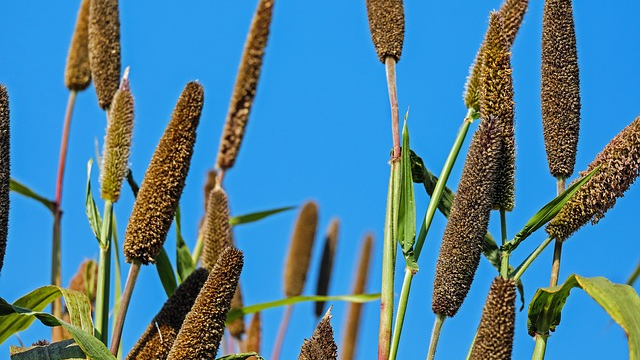
Millets are the flavour of the season. Essentially, millets are a group of small-seeded grasses that have been cultivated and consumed for thousands of years, especially in Africa and Asia. But in the past few years, millets have entered the superfood category and are a fad among fitness freaks. Millets require much lesser water than other popular cereals such as wheat and rice to grow and are high on nutrition. Many nutritionists believe they are a healthier alternative to wheat and rice, especially for those on a weight loss program.
Do you know India is one of the largest producers and consumers of millet in the world? There are several types of millet that are commonly found in India, including:
1. Foxtail Millet (Kangni or Thinai)
2. Finger Millet (Ragi or Nachni)
3. Pearl Millet (Bajra)
4. Barnyard Millet (Jhangora or Sanwa)
5. Little Millet (Kutki or Sama)
6. Kodo Millet (Kodon or Varagu)
7. Proso Millet (Cheena or Barri)
Each of these millets has its own unique taste, texture, and nutritional profile. They can be used to make a variety of dishes, including porridge, upma, idli, dosa, and roti. Millets are also commonly used in the preparation of traditional Indian foods like bhakri, khichdi, and bajra ki roti. Dr Aparna Govil Bhaskar, noted bariatric surgeon, says, “Millets have a lot of good nutritional properties. Indian diet is majorly carbohydrate based and that is one of the contributing factors when it comes to weight gain and obesity. Millets in turn are complex carbohydrates and can be used as a replacement for pure wheat flour.” “Complex carbohydrates add to the fibre content of the diet and help in increasing satiety levels. They are also low in calories and are gluten free. This reduces the total caloric intake and helps in overall weight loss”, she says.
Besides, they are a rich source of essential vitamins and minerals like magnesium, phosphorus, potassium, and calcium, which help to regulate blood pressure and maintain a healthy heart. They have a low glycemic index, which means that they release glucose slowly into the bloodstream, helping to regulate blood sugar levels. Millets are rich in antioxidants and phytonutrients, which help to boost the immune system and protect against disease.
They have a low glycemic index, which means that they release glucose slowly into the bloodstream, helping to regulate blood sugar levels. Millets are rich in antioxidants and phytonutrients, which help to boost the immune system and protect against disease.
They have a low glycemic index, which means that they release glucose slowly into the bloodstream, helping to regulate blood sugar levels. Millets are rich in antioxidants and phytonutrients, which help to boost the immune system and protect against disease.
Overall, incorporating millet into your diet can provide numerous health benefits and promote overall well-being.
Though they are high on nutrition, one should be careful of the quantity these should be consumed in. The recommended amount of millets to consume in a day varies depending on several factors, such as age, gender, body weight, physical activity, and overall health status. However, as a general guideline, it is recommended to consume about 1/2 to 1 cup of cooked millets per day.
Millets are a good source of complex carbohydrates, fiber, protein, vitamins, and minerals. However, they should not be the only source of nutrition in a balanced diet. It is important to also consume a variety of other whole grains, vegetables, fruits, legumes, nuts, and seeds to ensure adequate intake of all essential nutrients.
It is always recommended to consult a qualified nutritionist or healthcare professional to determine the optimal amount of millets and other foods to consume based on your individual needs and health goals.
Millets are a healthy and nutritious food, but consuming too much of any food can have negative effects on health. Overconsumption of millets can lead to several potential health issues, such as digestive problems, thyroid dysfunction. Millets are high in fiber, which can cause digestive problems like bloating, gas, and constipation if consumed in excess. Besides, millets contain goitrogens, compounds that can interfere with thyroid function and may lead to goiter or hypothyroidism if consumed in very large quantities.
Nutritionists also caution that though millets are a good source of minerals like iron and zinc, excessive consumption can lead to mineral imbalances in the body, which can affect overall health. Also millets are high in carbohydrates, and consuming too much can cause blood sugar levels to spike, especially in individuals with diabetes or insulin resistance. Studies also show that some individuals may be allergic to millets, and excessive consumption can lead to allergic reactions like hives, rashes, or even anaphylaxis.
“Though millets can be consumed in any clinical condition, moderation is the key. Since these are high in fiber so people who have been advised a low-fiber diet should consult their doctor before consuming it in high quantities. These could include people having an inflammation of the Gastrointestinal tract, those who have recently undergone gastric surgery,” says Mariam Lakdawala, a Mumbai-based nutritionist.
So, it is important to consume millets and other foods in moderation and to maintain a balanced and varied diet to ensure optimal health and well-being. If you have any concerns or health conditions, it is always recommended to consult with a qualified healthcare professional or nutritionist before making any significant changes to your diet.